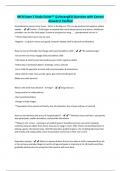MCH Exam 3 Study Guide** (julieyang83)-Question with Correct
Answers/ Verified
Hospitalization causes many issues - Stress is the Big one. This can be positive and negative, please
explain. - ✔️✔️Positive - Child begins to expand their world when parents are absent. Healthcare
providers can see the child adapt. If parents are gone too long........abandonment can set in.
**Stress helps them learn how to cope.
-Negative - Long term stress (not good), however display itself in physical manifestation.
Ways to interact friendly interchange with parents/address child: - ✔️✔️*No medical jargon
-Get to their eye level, engage child and address child
-Talk slowly & clearly (concrete words) assess child's cognitive ability
-Utilize play, transitional objects, drawings, colors, pictures
-Use a child life specialist to assist with communication & interactions
-Allow child to make noise and be upset, give child something to do.
[Make nice with parents]
What is the child most afraid of - 3 things? - ✔️✔️3 big stressors:
-losing control or independence
-their punishment/pain
-change in body images.
**[separation from parent and family, fear of unfamiliar, fear of pain and loss of control]
How can we minimize the stress of hospitalization? - ✔️✔️**Alleviate stress and fears: ask parents
stay participate, explain procedure, and provide distractions
**Ways to min. stress - rooming in w/ patient [parent should be primary source for coping &
comfort], bring an object from home, draw pic to hang in room, offer choices of watching movie or
picking a game, therapeutic play, child life specialist, guided imagery, role modeling (decrease fear
and anxiety and coping skills), move to procedure room [not in their own room]
Separation anxiety - ✔️✔️-Refers to severe distress that occurs when a child is separated from his
or her primary caretaker-Begins 6 months of age and peaks in intensity at 14-18 months and then
gradually declines;start to accept fact that parents will come back.
,How do we communicate with children? - ✔️✔️Children in general - Get to their level physically.
Simple words. Eye contact. Play to demonstrate. Approachable.
Communication: Hearing deficit - ✔️✔️sign language, pictures, computerized electronics, eye
contact, touch, turn light on. Gain their attention before speaking, face child when speaking, speak
slowly and loudly.
Communication:Visual deficit - ✔️✔️announce yourself, let them know that you are there. Keep
routine in the room the same. Make sure they have their glasses on. Bright lights.
Communication: Cognitive issues - ✔️✔️Be gentle and kind, very short directives. Praise. Hold
boundaries.
Adapting to deficits - ✔️✔️**Child will learn to adapt to deficits quickly, better to recognize
problem early on before they adapt, then harder to find the problems. May adapt to disabilities so
that you may not notice them
Basic fears of children are: - ✔️✔️separation, abandonment and fear of pain/unknown. [Infants
from 6 mos. through toddler hood - fear of separation.]
Separation comfort care - ✔️✔️-with favorite items or activity, distraction, parents room in or go
with child to procedures.
-Child will protest separation due to anxiety, [prep with tours and explanation, use transitional
objects] reinforce when they will see parent again.
-Despair follows due to grief of separation, detachment due to ongoing anger/coping skills.
Alleviate stress and fears: - ✔️✔️-explain procedure
-distraction
-ask parent to stay and participate in care
-explain what's going on
HOW they play in each of these stages?
, Note: primary school they tend to play in single sex groups.....and in high school they group by
interest groups. - ✔️✔️*5 types of play
• Solitary (0-2 Years) - infant/ toddlers. Adolescent. Child should be socialized. Can be at any stage,
but do not want this type of play only
• Parallel (2.5-3 Years) - toddlers. Two toddlers doing the same task, hasn't learned to play with each
other. Egocentric. (two children playing together but oblivious to the fact, don't understand the
concept of someone outside of themselves)
• Associative (3-4 Years) - preschool, early child. Get together to something accomplished, but no
rules.
• Organized/cooperative (4-6 Years) - school aged/adolescents. Organized sports, rules. Concept of
rules upholding. Need moderators. Sports w/Rules
• Onlooker/Spectator (2-2.5 Years) - toddlers, young preschool. RED flag if it continues with this type
of play; autism, cognitive development problems (can see in toddler or preschooler, but should want
to participate)
What is the benefit of play? - ✔️✔️- learn to socialize
-learning society rules
-communication; express thoughts
-learning fine & gross motor skills
-creativity & conceptualize
-master skills
-get stronger (muscles)
-Enables child to explore, express, solve problems
-Cognitive and Physical development, helps form independence over time.
-provides psychosocial needs of child
Nutrition is: - ✔️✔️the single most important factor in the growth and development of children.
Are food fads that different children encounter harmful? - ✔️✔️-No, and are usually self- limiting.
-Adolescents have many different needs for greater caloric intake and more concentrated iron, folic
acid, and protein.
Nutritional needs for baby's/infants - ✔️✔️-breast milk or formula for 1 full year.
-Solids; at around 6 mo. when Surge of growth is the greatest.




